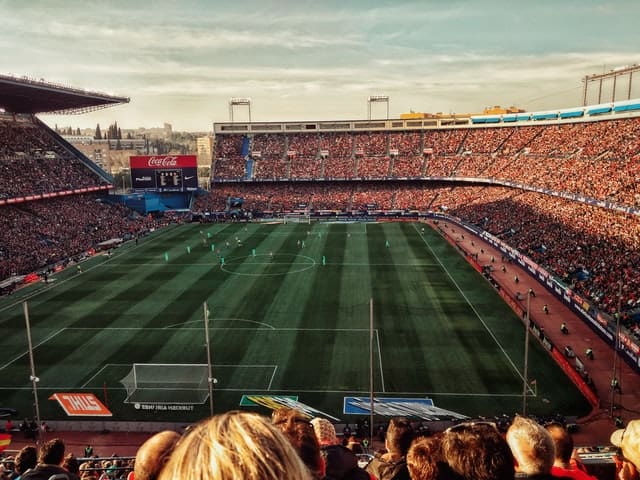You might not notice it immediately, but after you watch a number of soccer games, you may realize that the soccer fields that professional clubs around the world play at are not all of the same size.
Different soccer fields have different sizes. The FIFA rules allow for a wide range of soccer field dimensions. Soccer fields can range between 70 – 80 yards in width, and between 110 – 120 yards in length, and these dimensions are for the soccer fields that are used for international matches.
There are some soccer fields that are allowed to have a width somewhere between 50-100 yards which is a huge range as you can tell.
Some soccer leagues force a more strict range when it comes to field dimensions, but in general, many professional soccer fields have different dimensions.
So you get it, soccer fields vary a lot when it comes to pitch size, but the question is why. Why don’t all soccer stadiums have the same field size?
The main reason behind allowing different field sizes in soccer is to let the soccer clubs have a field advantage when they are playing at their home stadium. Soccer clubs get the chance to adjust the size of their home field based on the way they play and that gives them an advantage against their opponent.
Another reason for being flexible when it comes to the size of the soccer field is to make sure that clubs can build and maintain stadiums even if they aren’t financially stable.
Here are more details about each of the reasons mentioned above.
1- Different field sizes give soccer clubs an advantage on their home field.
Every professional soccer club in the big leagues around the world has their own stadium that they call home, and this home stadium is supposed to give the team an advantage over their opponent. This is part of the soccer culture and the way soccer leagues work.
Aside from the audience advantage that a soccer club has in their own stadium, they can also gain an advantage by using the most suitable field size for their team.
But you may ask, if both teams are going to play on the same field, then how can the field size really be an advantage for the home team? Well, here is how:
1.1 – The team picks a field size that fits their style of play.
Let’s say that a soccer team uses defensive strategies like “Park the bus” in order to win a game or at least end the match with a draw. Then a pitch with small size will work wonders for this team because the players will have to cover a smaller area to prevent their opponent from scoring.

If the field is smaller, then the team players can condense themselves in a smaller area in front of the goal instead of having to spread to cover a large area in case of a large field.
Another example is if a team is deadly with their counter attacks. Teams who rely on counter attacks need large fields in order to have more movement freedom and more spaces when they head towards their opponent’s goal.
So, these teams/clubs will definitely make sure that their home field is large enough for them to be able to maximize the threat of their counter attacks against their opponents.
1.2 – The team picks a field size that fits their player’s physical abilities
Not all soccer clubs have the finances and the experiences needed to make sure that their team players are capable of playing a full 90 minutes soccer match without having significant performance loss towards the end of the game.
Many soccer players get tired on large fields, and their performance might be affected during the second half of the game and during the extra halves that might be added at the end of the game.
For this reason, the soccer clubs who know that their players’ stamina is fit for smaller fields, then they’ll go for smaller soccer fields.
If you want to learn more about the duration of a soccer game and about the possible extra time, then you can check this article here.
2- Not all soccer clubs can afford to build and maintain large pitches.
It’s true that all of the soccer clubs that make it to the top soccer leagues around the world have enough money to build large stadiums and have large fields with changeable sizes (Soccer clubs can change the size of the pitch by just changing the dimensions of the white rectangle that marks the sides of the field), but remember, the rules apply for both the big clubs and the small clubs too.
For this reason, the soccer rules should keep in mind that some clubs might not be able to find large places to build their soccer field on, and that they might not be able to maintain the soccer field that’s covered with either natural or hybrid grass.
So, a soccer rule that allows the field of play to be within a flexible range makes total sense.
Is it fair to have stadiums of different field sizes?
I have mentioned that allowing different field sizes can give soccer clubs a field advantage on their home games. You may ask, is this really fair? Well… yes, it is fair.
The way most soccer leagues work is that a team plays 2 matches against the same opponent. One on their own field (called a home match), and one on their opponent’s field (called an away match). So the advantage is given to both teams since both of them will get a chance to play on their field against their opponent.
If you want to learn more about how this works, you can check this article that talks about the 2 legged matches in soccer.
SUMMARY
Soccer allows clubs to have different field sizes in order to give the clubs a chance to use the field size that fits their team’s style of play when they are on a home match. Also, allowing smaller field sizes means that more soccer clubs will be able to afford having their own official stadium.

